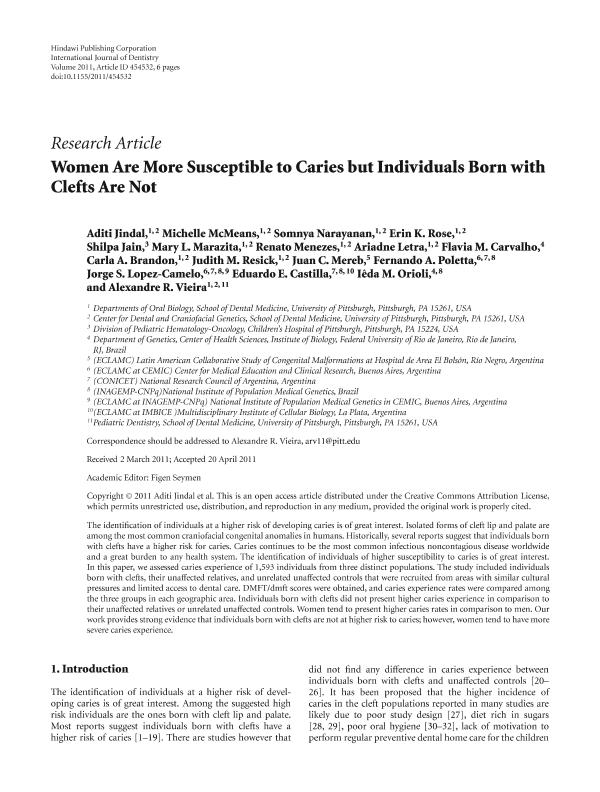Artículo
Women are more susceptible to caries but individuals born with clefts are not
Jindal, Aditi; McMeans, Michelle; Narayanan, Somnya; Rose, Erin K.; Jain, Shilpa; Marazita, Mary L.; Menezes, Renato; Letra, Ariadne; Carvalho, Flavia M.; Brandon, Carla A.; Resick, Judith M.; Mereb, Juan C.; Poletta, Fernando Adrián ; López Camelo, Jorge Santiago
; López Camelo, Jorge Santiago ; Castilla, Eduardo Enrique
; Castilla, Eduardo Enrique ; Orioli, Ieda Maria; Vieira, Alexandre R.
; Orioli, Ieda Maria; Vieira, Alexandre R.
 ; López Camelo, Jorge Santiago
; López Camelo, Jorge Santiago ; Castilla, Eduardo Enrique
; Castilla, Eduardo Enrique ; Orioli, Ieda Maria; Vieira, Alexandre R.
; Orioli, Ieda Maria; Vieira, Alexandre R.
Fecha de publicación:
06/2011
Editorial:
Hindawi Publishing Corporation
Revista:
International Journal of Dentistry
ISSN:
0020-6539
e-ISSN:
1687-8736
Idioma:
Inglés
Tipo de recurso:
Artículo publicado
Clasificación temática:
Resumen
The identification of individuals at a higher risk of developing caries is of great interest. Isolated forms of cleft lip and palate are among the most common craniofacial congenital anomalies in humans. Historically, several reports suggest that individuals born with clefts have a higher risk for caries. Caries continues to be the most common infectious noncontagious disease worldwide and a great burden to any health system. The identification of individuals of higher susceptibility to caries is of great interest. In this paper, we assessed caries experience of 1,593 individuals from three distinct populations. The study included individuals born with clefts, their unaffected relatives, and unrelated unaffected controls that were recruited from areas with similar cultural pressures and limited access to dental care. DMFT/dmft scores were obtained, and caries experience rates were compared among the three groups in each geographic area. Individuals born with clefts did not present higher caries experience in comparison to their unaffected relatives or unrelated unaffected controls. Women tend to present higher caries rates in comparison to men. Our work provides strong evidence that individuals born with clefts are not at higher risk to caries; however, women tend to have more severe caries experience.
Archivos asociados
Licencia
Identificadores
Colecciones
Articulos(IMBICE)
Articulos de INST.MULTIDISCIPL.DE BIOLOGIA CELULAR (I)
Articulos de INST.MULTIDISCIPL.DE BIOLOGIA CELULAR (I)
Citación
Jindal, Aditi; McMeans, Michelle; Narayanan, Somnya; Rose, Erin K.; Jain, Shilpa; et al.; Women are more susceptible to caries but individuals born with clefts are not; Hindawi Publishing Corporation; International Journal of Dentistry; 2011; 6-2011; 1-16
Compartir
Altmétricas



